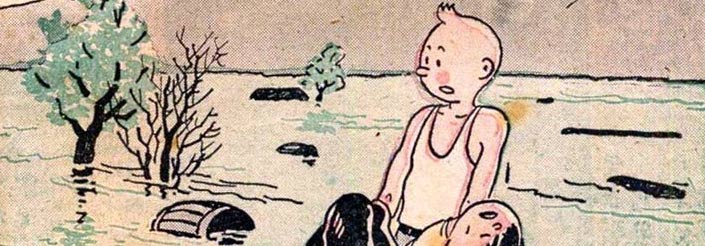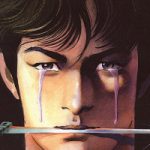Adventures of Tintin, The
Regions: Belgium

The Adventures of Tintin started as a modest weekly installment in “Le Petit Vingtième,” the youth pages of a small Catholic Belgian newspaper, “Le Vingtième Siècle” (The 20th Century). Its creator, Hergé (1907-1983), was totally taken by surprise by the success of this character, whose adventures were soon published in other Catholic magazines abroad (in France, Coeurs vaillants or “Brave Hearts,” 1930; in Switzerland, L’Écho illustré or “The Illustrated Echo,” 1932). This success encouraged the publisher to give the series exceptional commercial support, most noticeably by allowing the author to convert his serialized stories into a series of real books, first in black and white, later in full color. During WWII, Tintin’s adventures were serialized in the leading Belgian Newspaper “Le Soir” (The Evening), at that moment under Nazi control, and from 1946 on in a new magazine, Tintin, which Hergé ran as editor-in-chief of a studio whose production would epitomize the Franco-Belgian comics style of the golden age (1945-1965). Currently, The Adventures of Tintin has been translated into more than seventy languages, and the movie adaptation by Steven Spielberg (The Adventures of Tintin: The Secret of the Unicorn (2011), a motion capture 3D film version of three central volumes of the series), has shown it possible to find new forms and audiences for the character’s cross-medial afterlife.
A character blending the two prototypes of boy-scout and reporter-globetrotter, Tintin was inspired by the 1920s adventure strip Zig et Puce by Saint-Ogan as well as the cosmopolitan versions of travel literature then extraordinarily en vogue. Yet Hergé does much more than adapt these elements to a new, strongly moralizing use. Almost from the very beginning, he succeeds in building a new visual and narrative language for Francophone comics, which will remain influential until today.
It is the perfect mix of two strands that explains Tintin’s worldwide and lasting success. On the one hand, the fictional exploration of the real world–by an armchair travelling author catering to an audience whose knowledge of the larger world was quite limited. On the other hand, the exploration of many uncharted possibilities of the still very young comics medium. No less important however is the acclaimed “universalism” of the Tintin character, who is a kind of empty screen on which every reader, supposedly regardless of age, class, gender, and race can project herself. Visually speaking, Tintin, a popular exclamation meaning literally “nothing” in French, is a clear example of such a figure. A more minimalist face is hardly thinkable. Ideologically speaking, things are more complex, as demonstrated by the recurrent accusations of racism, misogyny, and anti-Semitism provoked by the first official volume of the series, Tintin in the Congo (1930). It cannot be denied however that the general evolution of the Tintin series leans more and more towards an ideal of universal humanism, no longer encapsulated in its original values. This broadening of the character’s ideological horizon is demonstrated by the generous and honest representation of the subaltern, be it Chinese (The Blue Lotus, 1936), black (The Red Sea Sharks, 1958), or gypsy (The Castafiore Emerald, 1963). Recent scholarship by Benoît Peeters and Jean-Marie Apostolidès has disclosed the deep autobiographical layers of Tintin. All these author-oriented readings confirm though the profound humanist vision that underpins the whole series.
Spanning almost half a century (the last album finished by the Hergé studio came out in 1976), The Adventures of Tintin are at first sight a straightforward illustration of the comics world axiom that characters never age or change. It should be noted that the initial adventure, Tintin in the Land of the Soviets (1929), a rather basic cartoon and blatant case of anti-Red propaganda, as well as the last, unfinished album, Tintin and Alph-Art (1986) were longtime discarded by the author from the list of the 22 canonical Tintin comics: a clear hint to the fact that Hergé himself was well aware of the fact that his work aimed at building a homogeneous world. As argued by many critics interested in the mythical structure of serialized comics, the stability of such a universe offers an imaginary counterpoint to the fast changing world of the audience. In the case of Tintin, this impression is deceiving. The Tintin universe changes as rapidly as the world outside, even if the stylistic makeover of many albums, redrawn for technical reasons at the moment of their colorization or updated for documentary reasons at the moment of their translation, may create the illusion of an immobile storyworld and visual design. In practice, however, each album of the series introduces smaller or bigger changes, which gradually reshape the form and content of the whole work.
Two fundamental mechanisms help understand the continuous evolution of The Adventures of Tintin. First, there are important changes in personnel. In the beginning, there is only Tintin and his speaking dog Snowy. But very soon Hergé introduces new characters, one after another, as if he had almost immediately understood that the Tintin character himself was not strong enough to carry the weight of such a large enterprise. The new characters will not only take Snowy’s place, and condemn him to become silent, they progressively expel Tintin from the center of the series. In the long run, the real heroes are those initially squeezed in as mere supporting characters: the stupidly incompetent but totally inoffensive detectives Thomson and Thompson, the often violent and sarcastic but exceptionally good-hearted Captain Haddock, the stereotypically distracted and no less conventionally genial Professor Calculus, the melodramatically exaggerated opera diva Bianca Castafiore, for instance. Moreover, these changes in personnel produce also a singular example of male bonding that disrupts the narrative logic of the series. Tintin, Haddock, and Calculus start living together in the mansion of Marlinspike, and as soon as Tintin leaves his anonymous Brussels apartment to move in with the characters whom certain critics have suggested to identify as his unconscious (Haddock) and superego (Calculus), he stops traveling around. Instead of leaving Belgium to the Soviet Union, the Congo, The United States, the Middle East, Latin America, and China, Scotland, and Northern Africa, he converts to the “home sweet home” way of life. After the purchase of Marlinspike, it is now the world that will come to Tintin, either to ask him for help or, more cynically perhaps, to bother him and his friends with a friendly presence none of them was asking for. In this sudden closure of the world, it is not impossible to recognize some elements of the growing disillusion of Tintin and his maker with the naïve ideals of the first adventures, when the reporter still wanted to save from evil the countries he visited.
These general thematic and narrative structures, which coincide biographically with the traumatic period before and after WWII, cannot be separated either from the no less radical changes in Hergé’s drawing style. Here as well, one can divide The Adventures of Tintin into two major periods, a distinction that the later makeover of the first albums cannot fully hide. Indeed, given the success of the series, the publishers have made new releases of the original versions and the wide circulation of this “old” material laid bare the spectacular transformations of Hergé’s style to new generations of readers. In the first half of the series, ending with The Secret of the Unicorn (1943) and Red Rackham’s Treasure (1944), the overall spirit is that of the “less is more” Clear Line style, not only in visual but also in narrative terms. The result is an increase of visual dynamism and narrative efficiency still unequaled in mainstream European comics. In the second period, the series undergoes a dramatic shift, with a growing emphasis on realism and photographic research. In both periods, the production context has played a decisive role. In the first half, Hergé had to work more or less alone, with not much pressure of the publisher. In the second half, which coincided with the shift from independent work to a studio system and the impact of the increasing industrialization of the comics industry, the role of Hergé changed radically. He became the supervisor of a team and most of the work of his studio, in which he felt less involved, was a more or less creative continuation of the old master’s style. This uneasy situation did not prevent however the making of some late masterworks, such as The Castafiore Emerald, a still unchallenged metanarrative on the role of media and communication in modern life.
–Jan Baetens


